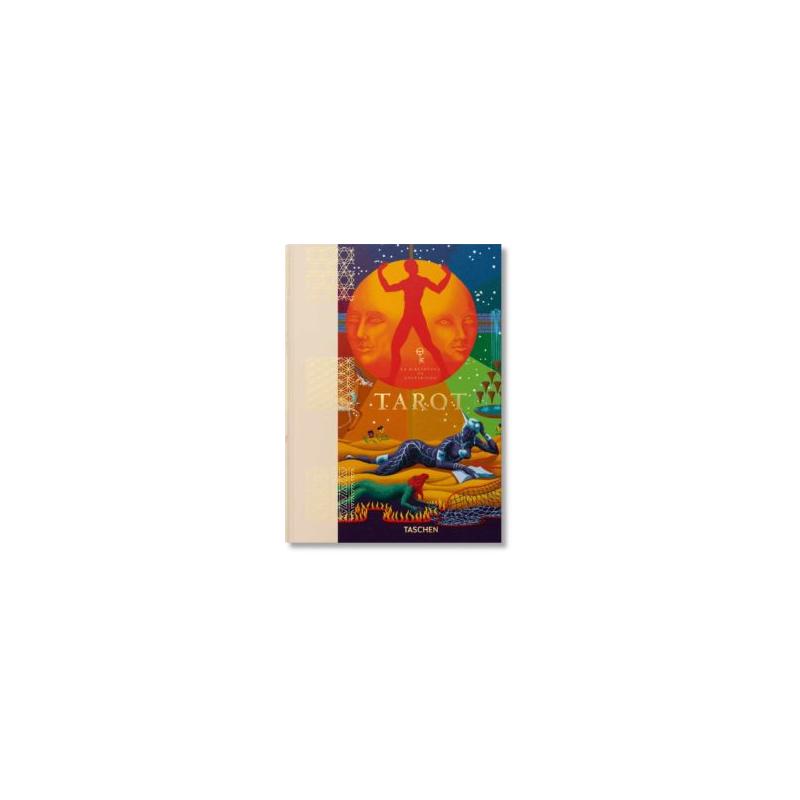Adéntrese en la historia oculta del tarot en el primer volumen de la Biblioteca de Esoterismo de TASCHEN, una serie que documenta las formas creativas con las que intentamos conectar con lo divino. Este compendio visual se organiza de acuerdo con la secuencia de arcanos mayores y menores, y reúne más de 500 cartas y obras de arte originales de...
Explorar el tarot es explorarnos a nosotros mismos, y nos recuerda el carácter universal del anhelo de significado, propósito y conexión con lo divino. Esta tradición de 600 años refleja no solo la historia de la adivinación, sino también nuestro viaje artístico y las formas en que los humanos expresamos la historia que compartimos.
Visto desde Occidente, el tarot ocupa para muchos un lugar en la penumbra de nuestra conciencia cultural compartida, y constituye una tradición metafísica que tiene su lugar en las polvorientas vitrinas de lo arcano. Su historia, larga y oscura, se ha transmitido por medio de textos secretos, la tradición oral y tomos académicos de sabios y filósofos. Cientos de años y de manos creativas (místicos y artistas que a menudo trabajaron juntos) han transformado lo que era en esencia un juego de salón en un sistema de adivinación y autoconocimiento y, a su vez, cada generación ha tratado de evolucionar la forma y reinterpretar el medio.
La autora Jessica Hundley rastrea esta fascinante historia en Tarot, el primer volumen de la serie de la Biblioteca de Esoterismo de TASCHEN. El libro explora el significado simbólico de más de 500 cartas y obras de arte originales, más de dos tercios de las cuales nunca se han publicado salvo como parte de la propia baraja. Es el primer compendio visual de este tipo, abarca desde la Edad Media hasta la época contemporánea y se organiza de acuerdo con la secuencia de arcanos mayores y menores de las 78 cartas de la baraja. Explora la poderosa influencia del tarot como musa de artistas de la talla de Salvador Dalí y Niki de Saint Phalle, e incluye las barajas de cerca de 100 artistas contemporáneos y diversos de todo el mundo que han adoptado este medio por su capacidad para impulsar la identidad cultural. Completan el volumen extractos de textos de pensadores como Éliphas Lévi, Carl Jung y Joseph Campbell; un prólogo de la artista Penny Slinger; una guía para la interpretación de las cartas de Johannes Fiebig; y un ensayo sobre barajas oraculares de Marcella Kroll.
Sobre la serie
La Biblioteca de Esoterismo explora el modo en que los artistas han dado forma al misticismo a lo largo de los siglos, y cómo han convertido lo arcano y oculto en obras de arte duraderas y visionarias. Cada tema se aborda por medio de imágenes antiguas y modernas procedentes de colecciones privadas, bibliotecas y museos de todo el mundo. El resultado es una historia visual inclusiva, un estudio de nuestra atracción instintiva por los sueños y las pesadillas, y de las formas creativas con las que intentamos conectar con lo divino.
-------
Delve into the hidden history of tarot in the first volume of the TASCHEN Esoteric Library, a series that documents the creative ways we try to connect with the divine. This visual compendium is organized according to the sequence of major and minor arcana, and brings together more than 500 cards and original works of art from ...
Exploring the tarot is exploring ourselves, and it reminds us of the universal character of the longing for meaning, purpose, and connection to the divine. This 600-year-old tradition reflects not only the history of divination, but also our artistic journey and the ways in which we humans express the history we share.
Seen from the West, the tarot occupies for many a place in the gloom of our shared cultural consciousness, and constitutes a metaphysical tradition that has its place in the dusty showcases of the arcane. Its long and dark history has been handed down through secret texts, oral tradition, and scholarly tomes by sages and philosophers. Hundreds of years and creative hands (mystics and artists who often worked together) have transformed what was essentially a parlor game into a system of divination and self-knowledge and, in turn, each generation has tried to evolve the form and reinterpret the medium.
Author Jessica Hundley traces this fascinating story in Tarot, the first volume in the TASCHEN Esoteric Library series. The book explores the symbolic meaning of more than 500 original cards and artwork, more than two-thirds of which have never been published except as part of the deck itself. It is the first visual compendium of its kind, it spans from the Middle Ages to contemporary times and is organized according to the sequence of major and minor arcana of the 78 cards in the deck. It explores the powerful influence of tarot as the muse of artists of the stature of Salvador Dalí and Niki de Saint Phalle, and includes the decks of nearly 100 contemporary and diverse artists from around the world who have embraced this medium for its ability to boost identity. cultural. The volume is completed by extracts from texts by thinkers such as Eliphas Lévi, Carl Jung and Joseph Campbell; a foreword by artist Penny Slinger; a guide to the interpretation of the letters of Johannes Fiebig; and an essay on oracle decks by Marcella Kroll.
About the series
The Library of Esotericism explores how artists have shaped mysticism over the centuries, and how they have turned the arcane and occult into lasting and visionary works of art. Each topic is addressed through ancient and modern images from private collections, libraries and museums around the world. The result is an inclusive visual story, a study of our instinctive attraction to dreams and nightmares, and the creative ways we try to connect with the divine.





